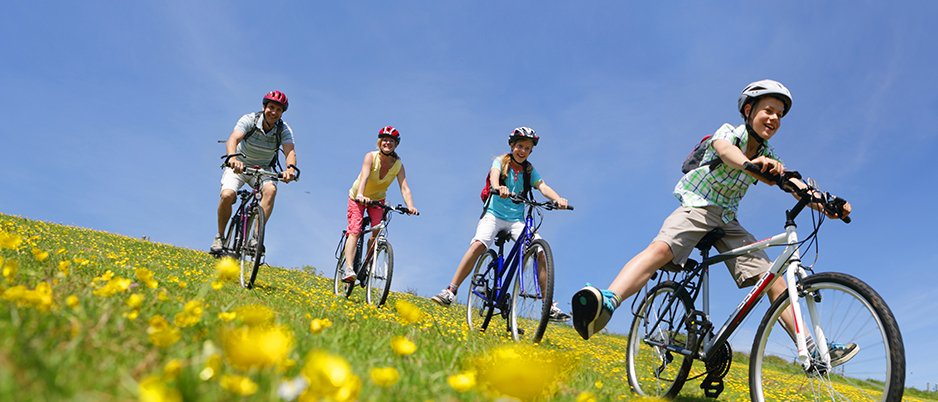
Choosing more environmentally-friendly ways to travel, like walking or cycling where possible, can help reduce your carbon footprint, and save you money.
You don't have to stop travelling altogether – it’s just about being more conscious of how you’re getting from A to B.
Choosing more sustainable ways to travel can help you:
Motorists in the UK spend over £2,500, on average, each year on their vehicle’s running costs, which includes around £1,200 on fuel.1 Swapping out shorter car journeys for walking, where possible, could help you save.
Walking and cycling can be a great way to improve your fitness levels, and manage stress. Taking a brisk walk to the shop instead of jumping in a car, or choosing to cycle to work also counts towards the recommended 150 minutes of weekly exercise.2
Regularly setting out on foot can also help reduce the risk of heart disease by 35%.3
Being more conscious of how you travel, and looking at ways to lower the emissions you produce from your journey, can help reduce your carbon footprint.
Buying food from local shops, or dining out at eateries, that use local and/or seasonal produce, can help reduce how far your food has travelled to get to your plate. Purchasing souvenirs and other goods, which have been made locally, can also help boost the local economy.
Alongside improved fitness and mental wellbeing, walking can be a great way to reduce your carbon footprint. Walking one mile a week instead of driving a petrol or diesel car can save 26kg of carbon dioxide a year.3
If you have children, perhaps you could walk to school instead of taking the car or bus. As well as helping children feel more refreshed and ready to learn, walking to school can help reduce the number of cars on the road during peak times.4
Walking is also free. You won’t need to pay for fuel and you won’t have to worry about paying for things like vehicle tax or maintenance.
As a zero-carbon form of transport, cycling can be a great way to travel from A to B.
After the initial cost of buying a bike and any cycling equipment, riding a bike is a cost-effective way to travel. You may need to do occasional maintenance, or update your home insurance policy to cover a bike, but you won’t need to pay for fuel or parking costs.
Cycling is also great exercise and can be easily incorporated into your day – especially if you plan on riding to work.
If you’re looking to commute by bike, see if you can benefit from the government’s cycle to work scheme.
Commuting via public transport is another way to reduce your carbon footprint. If you start catching the bus instead of driving a petrol or diesel car, you can reduce your CO2 emissions by 40%. If you get the train, you can reduce your CO2 emissions by 79%.5
Season passes, railcards and buying tickets in advance can help bring travel costs down. And you won’t have to pay for things like parking or, depending on where you live, the congestion charge – so the savings can quickly add up.
You’ll also be able to sail past the traffic in the bus lane and avoid having to drive around looking for a parking space.
You can also use public transport to travel outside the UK. The journey may take longer, but travelling by train can save a considerable amount in carbon emissions.
For example, taking the train from London to Barcelona produces 7kg of carbon emissions compared to flying, which would produce 180kg.6
There may be times when you’ll need to drive, but there are things you can do to help bring down costs and reduce your carbon footprint, such as:
A convenient way to access city centres, you drive to a designated car park and then catch a bus or train the rest of the way.
There may be a charge for using a local park and ride, which you’ll need to factor into your budget. But it could work out cheaper than driving the full distance, and you won’t need to pay for parking in the city centre.
If you’re looking for a new car, you may want to consider an electric vehicle (EV). While the initial cost can be higher than a petrol or diesel vehicle, an EV could save you money in the long run. They often have lower running costs and can help lower your carbon footprint.
Some employers are starting to offer EV schemes, which you may be able to benefit from.
Explore: A guide to electric vehicles
Whether it’s a business trip or a holiday, flying can have a considerable impact on the environment – accounting for around 2.4% of global CO2 emissions7. Before you take to the air, you could:
If you’re not travelling too far, you could look at other ways to make your journey, such as by coach or train.
1MoneyHelper: How to budget for a car and running costs
2NHS: Benefits of exercise
3Energy Saving Trust: Active travel: the benefits of walking, wheeling and cycling
4Energy Saving Trust: Why walking to school is the path to net zero
5Energy Saving Trust: Shared travel options
6Green Traveller: How to travel from the UK to Spain without flying